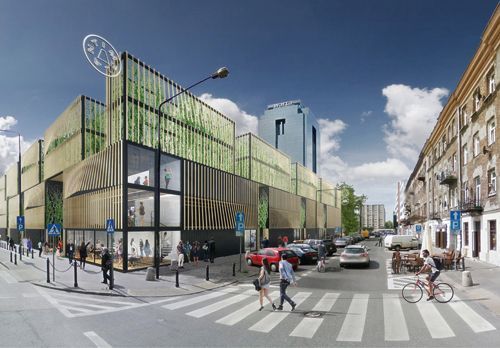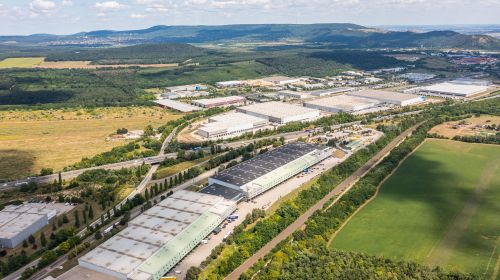A quick fix improves the mix
Architecture
They say in Poland that there’s nothing more durable than a quick fix. This sardonic and somewhat paradoxical observation reflects the negative collective memory of the ineptitude, banality and inadequacy usually associated with the communist era. Although that system is now gone, pejorative associations with the ‘indestructibility’ of quick fixes persist. Just enter the Polish word [‘prowizorka’] into a search engine, and the browser will generate over 130,000 results connected to almost every area of everyday life. But does a quick fix have to be a bad thing? The Eiffel Tower, after all, was intended to be dismantled after 20 years, but still became a permanent fixture and a symbol of Paris...
The Czech market
The quick fix can be a wonderful solution for developers or investors waiting for the paperwork to go through for a planned project, or for those who are not yet sure what to build on their plot. By opting for a temporary development or arrangement of the site, benefits can be generated for both its owner and the local community, breathing life back into a neglected quarter of the city. One such project, which has been awaiting development for years, is an office complex to be built on the site of the historic Masarykovo nádraží railway station, which is situated almost in the centre of Prague. Penta Real Estate acquired an 80 pct stake in the project in 2011 and has been planning to develop a 70,000 sqm office complex, even bringing in such a prestigious studio as Zaha Hadid Architects to design the EUR 250 mln project. But until the preparatory and development work can get underway on such a culturally sensitive project, Penta has given the old buildings and site over to the Manifesto Market initiative, which started up in June this year. A market with 27 containers is now operating in the old station. And it’s full of life once again – you can eat there, drink, listen to music, and watch a show or a concert. The project was initiated by Martin Barry, the founder of non-profit organisation ReSite, in a partnership with Aerofilms.
And by cooperating with Mastercard, the Manifesto Market is now also the first completely non-cash commercial area in the Czech Republic. “It bears all the hallmarks of a completely off-the-wall venture, but everyone I talked to – the owner of the plot (Penta Real Estate), the organisers of the Superstudio competition, the curators of the events programme and the potential future tenants – agreed that this is a good idea. We can bring new life to this rundown site, stimulate local business, provide an innovative place for local culture and diversify the tourism experience. We are doing this with a diverse palette of collaborators, but we know that it will not last forever – and that’s part of the charm of this undertaking,” claims Martin Barry. “It will be a temporary structure, but we want the building to feature high quality architecture. We believe that Prague deserves a project that can be compared to those that are popular in London, Lisbon, Taipei and other major cities,” he adds.
Getting there before the postman
The citizens of Prague are already enjoying the charms of this latest ‘quick fix’, but similar attractions are expected to be available to Warsaw’s inhabitants by the end of this year. At least this is what Nowa Epoka Handlu has been telling us. It plans to assemble the Implant on the derelict site of a pre-war postal train station. The plot is still owned by Poczta Polska [the Polish Post], which first wanted to sell the site for a skyscraper project, but later decided to lease it out. This was done at the end of last year. For five years, the plot at the junction of ul. Chmielna and ul. Żelazna will be managed by Nowa Epoka Handlu, which is planning to assemble a three-level, pre-fab shopping and cultural centre designed by the Jakub Szczęsny studio and consisting of 272 containers. “We want the Implant to have social functions and to be an important venue for cultural events to add to its commercial activities. This is an absolutely unique project and the first of its kind in Poland. We are attaching great importance to the selection of its tenants and the partners with whom we will cooperate. The Implant is our baby and so we want the project to fulfil the expectations on which the concept is based. We are building a community-friendly centre, which will feature a range of attractions, because as well as the commercial aspects we will focus on the atmosphere, the character of the centre and on being open to new ideas and the needs of the local community. It will not be our place. It will be for the public and due to its diverse nature it should become a living part of the fabric of the city,” believes Łukasz Koziński, the CEO of Nowa Epoka Handlu.
The Implant is to be divided into three main zones: a catering section – with a separate restaurant area; a service and retail zone populated with small boutiques mostly offering products from Polish designers; as well as an events hall for social and cultural events. This will be a venue for workshops, exhibitions and lectures.
Before the first hole is dug
Despite their innovativeness and potential, both projects are not the first attempts to revive space as ‘plan Bs’ for project sites. One of the first in Poland to gain nationwide recognition was the scheme introduced at the Off Piotrkowska re-development in Łódź. “Even with minimal capital involvement, a derelict quarter can earn a cult following while the location is being prepared for a more classic development project. Unfortunately, the initial plans for this major reconstruction and renovation project had to be put back due to the global financial crisis, which is why the project in its original form no longer made sense. The problem that needed to be resolved was the unstructured tenant-mix strategy and the poor technical condition of the buildings. As an asset manager, we were faced with a choice: either to continue our cooperation with the tenants we had at that time, who provided a relatively stable and satisfactory income but were not going to contribute to building the long-term value of the property, or to start again. We opted for the latter approach,” explains Michał Styś, the CEO of OPG Property Professionals. “Our idea was clear: firstly, we had to focus on people and their ideas, and secondly on the buildings. This was done through cooperation on the marketing and PR for the site. The next stage was to offer rent discounts for the new tenants, so they could renovate and fit-out the areas where they will mainly be concentrated. However, the most important thing was their selection. We wanted to create a lively place, offering a unique experience and equally unique brands that you cannot find in a typical chain store. We brought art, culture, creative industries and some remarkable gastronomy inside the old, post-industrial walls. Recently we have been supplementing Off’s creative ecosystem by bringing in representatives of the IT and technology sectors, start-ups and local business leaders. So we can say that we had a hipster-like approach, because we started to do place-making in Poland before this phenomenon had even been given a name,” reveals Michał Styś, who is now developing two office buildings on ul. Piotrkowska and plans to fully renovate the buildings of the former Ramisch factory while continuing to give them further functions.
Capital Park faced a similar challenge in Warsaw in 2008, when it took on the task of revitalising the buildings of the former Norblin factory, once owned by the Buch Brothers and T. Werner. “Because the majority of these are under protection orders, we estimated that the process for agreeing on the final form of the project, as well as obtaining all the permits needed to start the construction work, could take several years. However, we did not want the site to remain unused all that time. That’s why we decided to launch BioBazar in the historic grounds of Norblin – the first 100 pct organic food market in Poland,” recalls Kinga Nowakowska, the operational director and a board member of Capital Park Group. “BioBazar operated in the factory for almost seven years, having opened at the end of November 2010. At the very beginning, the shopping zone comprised a single hall of about 200 sqm, where 30 farmers could sell their produce. Over time, the popularity of the market took off and so it continued to grow in size from one year to the next. By the time the construction work started on ArtN, it had grown to five halls with a total of almost 2,000 sqm and 130 regional producers trading in it,” claims the head of Capital Park. As well as this eco-market, the ‘City and Garden’ exhibition was held in Norblin in 2014, featuring an urban garden and environmental workshops.
BioBazar’s temporary concept proved to be so successful that it has been moved to Służewiec for the construction period and will return to Norblin after its completion, occupying 1,700 sqm.


The architectural concept by Nikola Karabcová, Lucie Červená and Elvira Islas for Manifesto Market [left]; Penta’s EUR 250 mln project was designed by the Zaha Hadid Architects studio [right]
Ingenuity pays off
These are just a few examples of well-tailored quick fixes. Real estate before it starts to take its final form can be used in various ways: as clubs, temporary theatre stages, as just a car park – or even as a training ground for marines. However, not every use is beneficial for the city. “Such temporary activities by commercial developers are a way to arouse interest in a given site and create a community around it before the actual construction work begins. The element of surprise is important here, because people living or working in the neighbourhood have usually become used to seeing an undeveloped plot. By introducing some temporary use or holding events on it, the investor is communicating its openness and its city-forming intentions to the local community. And the less recognisable the location of a project is, the more important it is to attract people to it to familiarise them with it. Thus this kind of place-making mainly has a PR dimension, but if it is well-done, it could increase the interest of potential tenants or apartment buyers in that particular project,” suggests Jan Jakub Zombirt, the director of JLL’s strategic consulting department.
It depends on the developer or investor how they choose to use a site that is still waiting for better times. From the financial perspective, it doesn’t matter so much whether it’s used as a car park or in a way that is more attractive for the local residents. But it does become much more important when the image of the company and the success of the project are considered.





















































